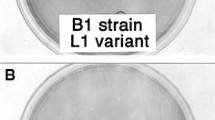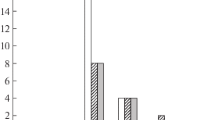Summary
Semliki Forest Virus (SFV), Newcastle Disease Virus (NDV) and Vesicular Stomatitis Virus (VSV) were selected on account of their capacity to induce and to be affected by interferon. They were tested in mouse L cells by the plaque method with, or without the addition of mouse anti-interferon serum (MAIS) into the nutrient ‘Agarose’ layer.
Only SFV plaques were greatly enlarged by MAIS. The number of enlarged plaques was augmented by increased amounts of MAIS. When high doses of MAIS were used, SFV plaques were observed to be of approximately the same size and were all large. This result suggests that smallest SFV plaques were produced by virus particles that induced more interferon than did others, since the highest concentrations of MAIS were necessary for their maximal development.
NDV plaques size was slightly increased by MAIS, indicating that the virus was a little sensitive to interferon. Abortive replication of the virus in L cells could not, however, be related to a possible auto-inhibiting phenomenon.
When a mixed population of large plaque and small plaque variants of VSV was grown with MAIS, only large plaques were obtained. This data supports the view that VSV small plaque variant produces interferon and can be considered a self-inhibiting virus.
With these results, conditions for virus plaque enhancement by MAIS were defined.
Similar content being viewed by others
References
Boxaca, M., andK. Paucker: Neutralization of different murine interferons by antibody. J. Immunol.98, 1130 (1967).
Buckler, C. E., K. T. Wong, andS. Baron: Induction of the interferon system by various inducers. Proc. Soc. exp. Biol. (N.Y.)127, 1258 (1968).
Cooper, P. D.: An improved agar cell-suspension plaque assay for poliovirus: some factors affecting efficiency of plating. Virology13, 153 (1961).
Fauconnier, B.: Antigenic identity of interferons induced by different viruses in the same cell system. Nature (Lond.)214, 5088 (1967a).
Fauconnier, B.: Parenté antigénique des interférons induits par des agents viraux ou bactériens et par le statolon chez la souris. C. R. Acad. Sci. (Paris)264, 1814 (1967b).
Fauconnier, B.: Production de sérums anti-interféron de cellules L de souris chez le lapin. Ann. Inst. Pasteur113, 757 (1967c).
Fauconnier, B.: Enhancing effect of interferon antiserum on virus growth. Nature (Lond.)222, 185 (1969).
Finter, N. B.: Interferon production and sensitivity of Semliki Forest Virus variants. J. Hyg. (Lond.)62, 337 (1964).
Friedman, R. M.: Role of interferon in viral interference. Nature (Lond.)201, 1848 (1964).
Henle, W., G. Henle, F. Deinhard, andV. V. Berg: Studies on persistent infection in tissue culture. IV. Evidence for production of interferon in MCN cells by myxoviruses. J. exp. Med.110, 525 (1959).
Ho, M.: Interferons. New Engl. J. Med.266, 1258 (1962).
Isaacs, A., andI. Lindenmann: Virus interference. I. The interferon. Proc. roy. Soc. Ser. B147, 258 (1957).
Lockart, R. Z., Jr.: Variation in the abilities of several lines of L cells to produce and to be affected by interferon. J. Bact.89, 117 (1965).
Paucker, K., Z. Skurska, andW. Henle: Quantitative studies on viral interference in suspended L cells. I. Growth characteristics and interfering activities of vesicular stomatitis, Newcastle Disease and Influenza A viruses. Virology17, 301 (1962).
Paucker, K.: The serologic specificity of interferon. J. Immunol.94, 371 (1965).
Riley, B. P., S. Toy, andG. E. Gifford: Relative effect of interferon on virus plaque formation. Proc. Soc. exp. Biol. (N.Y.)122, 1142 (1966).
Toy, S. T., andG. E. Gifford: Interferon production with different multiplicities of Semliki Forest Virus. Proc. Soc. exp. Biol. (N.Y.)126, 787 (1967).
Wagner, R. R., A. H. Levy, R. M. Snyder, G. A. Ratcliff, andD. F. Hyat: Biological properties of two plaque variants of vesicular stomatitis virus (Indiana serotype). J. Immunol.91, 112 (1963).
Wilcox, W. C.: Quantitative aspect of anin vitro virus-induced toxic reaction. I. General aspects of the reaction of Newcastle disease virus with L cells. Virology9, 30 (1959).
Youngner, J. S., andA. W. Scott: Relation of interferon synthesis to abortive replication of Newcastle Disease virus in L cells. J. Virol.2, 81 (1968).
Author information
Authors and Affiliations
Rights and permissions
About this article
Cite this article
Fauconnier, B. Viral auto-inhibition studied by the effect of anti-interferon serum on plaque formation. Archiv f Virusforschung 31, 266–272 (1970). https://doi.org/10.1007/BF01253761
Received:
Issue Date:
DOI: https://doi.org/10.1007/BF01253761




